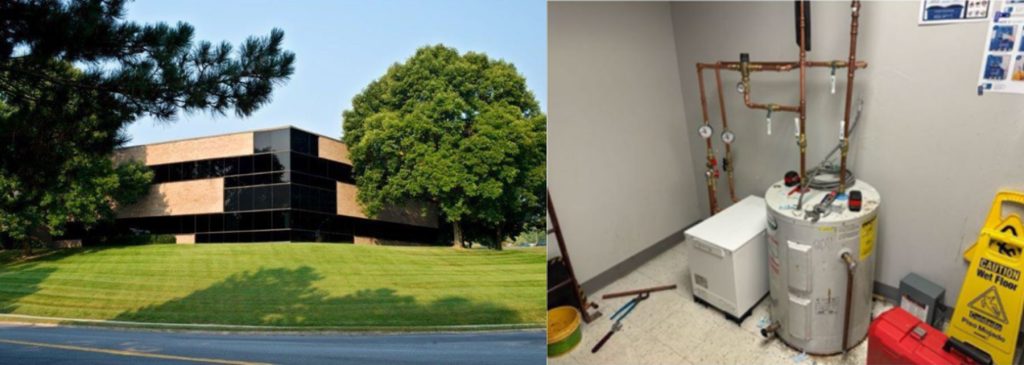Project Overview:
Under the NextGen Buildings Innovation program, Sunamp is installing thermal batteries at eight different sites, paired with both new and existing heating systems to provide sustainable and efficient domestic hot water and heating.
The Latham office building, home to 114 workers, serves as one of the pilot locations for this initiative. The goal of the project is to compare the efficiencies of the previous system, which included an AO Smith 30-gallon electric tank water heater, with the new electrically charged Sunamp Thermino 70e, providing a more sustainable solution for domestic hot water.
Sunamp’s electrically charged thermal battery was installed in parallel with the existing electrically charged tank, allowing for a direct comparison of performance between the two systems.
Existing System Overview:
The building previously used an AO Smith 30-gallon standard electric tank water heater for domestic hot water production.
The Sunamp Solution:
The Thermino 70e thermal battery, electrically charged from the grid, will replace the existing water heater, providing a more efficient and sustainable solution for domestic hot water.
Results and Findings
Peak hot water consumption typically occurred at midday, closely followed by peak energy usage. This presented an opportunity to use the thermal battery to shift electricity demand to off-peak times, reducing both energy costs and GHG emissions.
Based on monitoring results, a timer was added to the thermal storage system, allowing it to charge during off-peak hours. Sunamp’s Thermino drew a maximum current of 10.6 A, which is 29.25% lower than the 15.2 A drawn by the tank water heater, significantly reducing the load on the building’s energy system.
Impact & Conclusion: Enhancing Energy Efficiency and Sustainability
Charging the thermal battery consumed an average of 7.42 kWh/day and 2.71 MWh annually, while the tank water heater consumed slightly more at 7.55 kWh/day and 2.76 MWh/year.
The difference in GHG emissions between the two systems was minimal, with Sunamp’s thermal battery producing 0.663 tons CO2e/year, compared to the tank water heater’s 0.675 tons CO2e/year.
A more significant benefit was the 29% reduction in peak electrical load used by the water heating equipment. The peak load decreased from 3107 W for the tank water heater to 2198 W for the thermal battery.
This project demonstrated the peak load reduction capability of Sunamp’s PCM thermal battery with an internal electric resistance heater, compared to a typical electric hot water heating system.
NYSERDA NEXTGEN Building Innovation Program:
The NYSERDA (New York State Energy Research & Development Authority) NEXTGEN Building Innovation program aims to help New York State achieve a carbon-neutral economy by 2050, with a goal of reducing greenhouse gas emissions by at least 85% from 1990 levels.
The NYSERDA NextGen Buildings program is dedicated to accelerating the development and commercialization of innovative technologies that enable the electrification and decarbonization of New York State’s building stock. By supporting the adoption of cutting-edge building innovations, the program seeks to make buildings cleaner, more energy-efficient, load-flexible, and resilient in the face of climate change.
As part of this initiative, Sunamp is deploying thermal batteries at eight different sites across the state, integrating these systems with both existing and new infrastructure to deliver domestic hot water and heating in a cleaner, more energy-efficient manner.


